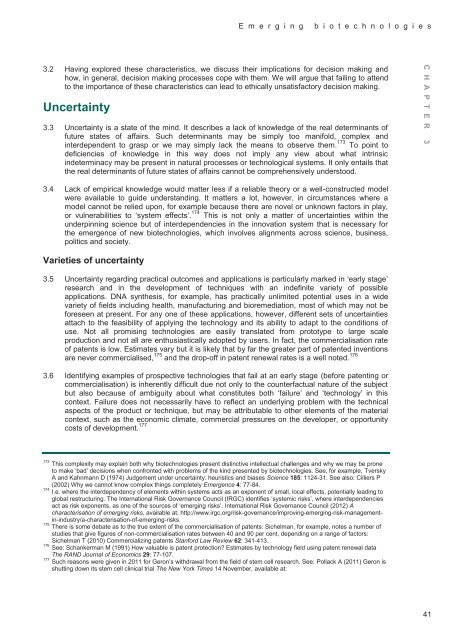Emerging biotechnologies: full report - Nuffield Council on Bioethics
Emerging biotechnologies: full report - Nuffield Council on Bioethics
Emerging biotechnologies: full report - Nuffield Council on Bioethics
Create successful ePaper yourself
Turn your PDF publications into a flip-book with our unique Google optimized e-Paper software.
E m e r g i n g b i o t e c h n o l o g i e s<br />
3.2 Having explored these characteristics, we discuss their implicati<strong>on</strong>s for decisi<strong>on</strong> making and<br />
how, in general, decisi<strong>on</strong> making processes cope with them. We will argue that failing to attend<br />
to the importance of these characteristics can lead to ethically unsatisfactory decisi<strong>on</strong> making.<br />
Uncertainty<br />
3.3 Uncertainty is a state of the mind. It describes a lack of knowledge of the real determinants of<br />
future states of affairs. Such determinants may be simply too manifold, complex and<br />
interdependent to grasp or we may simply lack the means to observe them. 173 To point to<br />
deficiencies of knowledge in this way does not imply any view about what intrinsic<br />
indeterminacy may be present in natural processes or technological systems. It <strong>on</strong>ly entails that<br />
the real determinants of future states of affairs cannot be comprehensively understood.<br />
C H A P T E R 3<br />
3.4 Lack of empirical knowledge would matter less if a reliable theory or a well-c<strong>on</strong>structed model<br />
were available to guide understanding. It matters a lot, however, in circumstances where a<br />
model cannot be relied up<strong>on</strong>, for example because there are novel or unknown factors in play,<br />
or vulnerabilities to ‘system effects’. 174 This is not <strong>on</strong>ly a matter of uncertainties within the<br />
underpinning science but of interdependencies in the innovati<strong>on</strong> system that is necessary for<br />
the emergence of new <str<strong>on</strong>g>biotechnologies</str<strong>on</strong>g>, which involves alignments across science, business,<br />
politics and society.<br />
Varieties of uncertainty<br />
3.5 Uncertainty regarding practical outcomes and applicati<strong>on</strong>s is particularly marked in ‘early stage’<br />
research and in the development of techniques with an indefinite variety of possible<br />
applicati<strong>on</strong>s. DNA synthesis, for example, has practically unlimited potential uses in a wide<br />
variety of fields including health, manufacturing and bioremediati<strong>on</strong>, most of which may not be<br />
foreseen at present. For any <strong>on</strong>e of these applicati<strong>on</strong>s, however, different sets of uncertainties<br />
attach to the feasibility of applying the technology and its ability to adapt to the c<strong>on</strong>diti<strong>on</strong>s of<br />
use. Not all promising technologies are easily translated from prototype to large scale<br />
producti<strong>on</strong> and not all are enthusiastically adopted by users. In fact, the commercialisati<strong>on</strong> rate<br />
of patents is low. Estimates vary but it is likely that by far the greater part of patented inventi<strong>on</strong>s<br />
are never commercialised, 175 and the drop-off in patent renewal rates is a well noted. 176<br />
3.6 Identifying examples of prospective technologies that fail at an early stage (before patenting or<br />
commercialisati<strong>on</strong>) is inherently difficult due not <strong>on</strong>ly to the counterfactual nature of the subject<br />
but also because of ambiguity about what c<strong>on</strong>stitutes both ‘failure’ and ‘technology’ in this<br />
c<strong>on</strong>text. Failure does not necessarily have to reflect an underlying problem with the technical<br />
aspects of the product or technique, but may be attributable to other elements of the material<br />
c<strong>on</strong>text, such as the ec<strong>on</strong>omic climate, commercial pressures <strong>on</strong> the developer, or opportunity<br />
costs of development. 177<br />
173 This complexity may explain both why <str<strong>on</strong>g>biotechnologies</str<strong>on</strong>g> present distinctive intellectual challenges and why we may be pr<strong>on</strong>e<br />
to make ‘bad’ decisi<strong>on</strong>s when c<strong>on</strong>fr<strong>on</strong>ted with problems of the kind presented by <str<strong>on</strong>g>biotechnologies</str<strong>on</strong>g>. See, for example, Tversky<br />
A and Kahnmann D (1974) Judgement under uncertainty: heuristics and biases Science 185: 1124-31. See also: Cilliers P<br />
(2002) Why we cannot know complex things completely Emergence 4: 77-84.<br />
174 I.e. where the interdependency of elements within systems acts as an exp<strong>on</strong>ent of small, local effects, potentially leading to<br />
global restructuring. The Internati<strong>on</strong>al Risk Governance <str<strong>on</strong>g>Council</str<strong>on</strong>g> (IRGC) identifies ‘systemic risks’, where interdependencies<br />
act as risk exp<strong>on</strong>ents, as <strong>on</strong>e of the sources of ‘emerging risks’. Internati<strong>on</strong>al Risk Governance <str<strong>on</strong>g>Council</str<strong>on</strong>g> (2012) A<br />
characterisati<strong>on</strong> of emerging risks, available at: http://www.irgc.org/risk-governance/improving-emerging-risk-managementin-industry/a-characterisati<strong>on</strong>-of-emerging-risks.<br />
175 There is some debate as to the true extent of the commercialisati<strong>on</strong> of patents: Sichelman, for example, notes a number of<br />
studies that give figures of n<strong>on</strong>-commercialisati<strong>on</strong> rates between 40 and 90 per cent, depending <strong>on</strong> a range of factors:<br />
Sichelman T (2010) Commercializing patents Stanford Law Review 62: 341-413.<br />
176 See: Schankerman M (1991) How valuable is patent protecti<strong>on</strong>? Estimates by technology field using patent renewal data<br />
The RAND Journal of Ec<strong>on</strong>omics 29: 77-107.<br />
177 Such reas<strong>on</strong>s were given in 2011 for Ger<strong>on</strong>’s withdrawal from the field of stem cell research. See: Pollack A (2011) Ger<strong>on</strong> is<br />
shutting down its stem cell clinical trial The New York Times 14 November, available at:<br />
41
















